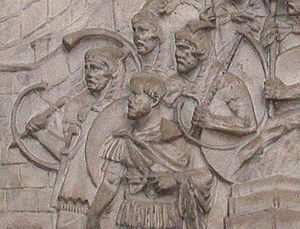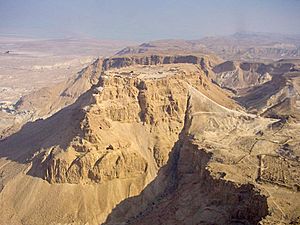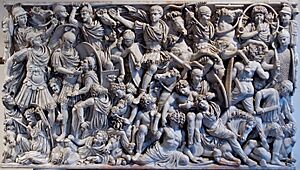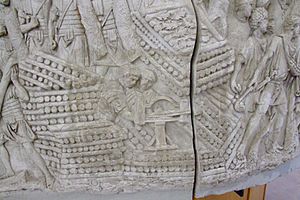Military of ancient Rome facts for kids
The Military of ancient Rome was made up of all the fighting forces of Ancient Rome. This includes the Roman army and, later, a small navy. The navy was added around 320 BC during the Second Samnite War.
The Roman military was a very important part of the Roman state. It had a history of over 1300 years! Roman armies fought in places as far away as Parthia (modern-day Iran) and Africa, and even in the British Isles.
After many changes, the army became highly trained and well-equipped. The Romans also had a strong navy that controlled the Mediterranean Sea and the European Atlantic coast. Later, the military grew much larger to protect the borders and keep peace inside the empire. The Western Roman Empire started to rely a lot on soldiers from Germanic tribes who lived within its borders. These tribes fought for Rome during the Migration period.
Contents
Who Were the Soldiers?

For most of its history, only men could join the Roman army. At first, only Roman citizens could serve as legionaries. However, many non-citizens could join as auxiliaries, and sometimes they could earn citizenship in return.
In the beginning, Rome's army was made up of citizens who served for a year as part of their duty. They fought short campaigns against local enemies. As Rome grew, its forces became more professional. Soldiers started to get paid and serve for longer periods. The army had citizen infantry units called legions and allied troops called auxilia. Auxiliaries often provided light infantry or cavalry support.
Later, the army continued to be professional, but it started to use more allied or mercenary troops. These troops became a large part of Rome's forces. The army also became less uniform, with different types of soldiers, from lightly armed archers on horseback to heavy infantry. Cavalry also became more important than infantry, and the army focused more on moving quickly.
Military Culture
Roman military culture was very tough. Discipline was strict, and training was hard. This was all meant to build strong teamwork and a sense of unity among the soldiers. Unlike some enemies who fought as individuals, Roman training focused on working together. Soldiers had to keep their formations in battle and use efficient stabs with their swords, rather than wild swings.
Soldiers were loyal to the Roman state, but they also had great pride in their own unit. Each unit had a special military standard, like the legionary eagle for legions. Successful units were given special names, such as the 20th legion, which became the XX Valeria Victrix (meaning "Valiant and Victorious 20th").
How the Military Was Paid For
At first, soldiers were expected to provide much of their own equipment. But eventually, the Roman military was almost entirely paid for by the state. Early Roman soldiers were unpaid citizens, so the army didn't cost the state much money back then.
However, the military always represented the biggest expense for the Roman state. During Rome's expansion, Roman armies brought in money by taking valuable things from conquered lands. They would show off this wealth in special parades called triumphs.
But after the Roman Empire stopped expanding in the 2nd century CE, this source of money dried up. By the end of the 3rd century CE, Rome was no longer conquering new lands. Paying for the military became a huge problem for Rome's finances.
Several things made military spending even higher. First, Rome paid large rewards to "barbarian" leaders to keep them peaceful and to get allied troops from them. Second, the military grew much larger. Third, the army started to use more cavalry units, which were much more expensive to keep than infantry units.
As military costs increased, new taxes were created or old tax laws were changed. However, many people could not be taxed, such as slaves or Roman citizens. Many others were already poor from years of war and often left their lands to try and survive in cities.
Military Strengths
Readiness and Location
Rome's military strength was mainly based on keeping an active fighting force along its borders. This is shown by where the Roman legions, the main part of the army, were placed. Because of these placements, the Roman military did not keep a large central group of reserve troops for a long time. These reserves were only brought back later in the Roman Empire, when the army was split into a border defense force and mobile units that could respond quickly.
Showing Power
The Roman military was very good at showing its power. It often removed foreign rulers by force or by scaring them, and then replaced them with rulers who would follow Rome's orders. This was helped by having many client states and other controlled areas beyond Rome's official borders. Rome had a lot of political and military control over these areas.
Keeping Supplies Going
The Roman Empire had a huge network of well-maintained roads. It also controlled the Mediterranean Sea for most of its history. This allowed for a basic form of quick response, similar to what modern armies aim for. Border troops were usually very good at stopping enemies before they could get far into Roman territory.
The Roman military also had a very good system for getting supplies. There wasn't a special part of the military just for logistics, but the Roman Navy did a lot of this work. It was much easier and cheaper to transport goods by sea and river than over land. For example, Roman armies fighting in Germania were supplied from Italy and Gaul. Supplies were sent by sea to the northern coast of Germania, and then by barges on rivers further inland.
Policing
Most Roman cities had a civil guard to keep the peace. However, these guards were not allowed to be armed like soldiers, because of fears of rebellions. Policing was split: the civil guard handled small problems, while the Roman legions and auxiliaries dealt with bigger riots and rebellions.
Engineering Skills

The military engineering of Ancient Rome's armed forces was amazing. It was much bigger and more frequent than any other army of its time. In fact, engineering was a key part of Roman military culture. Every Roman legionary carried a shovel as part of his equipment, along with his gladius (sword) and pila (spears). Learning to build, and build quickly, was a standard part of their training.
This engineering skill was most clear during the peak of Roman military power, from the middle of the Republic to the middle of the Empire. Before and after this period, there is less evidence of such impressive engineering feats.
Roman military engineering included both routine tasks and extraordinary projects. Routine engineering involved building fortified camps regularly, building roads, and making siege engines. The knowledge gained from these daily tasks helped with bigger projects, like the huge walls built around Alesia and the earthen ramp built at Masada.
This engineering expertise also helped in building siege equipment like ballistae, onagers, and siege towers. It also allowed troops to build roads, bridges, and fortified camps. All of these skills gave Roman troops big advantages. They could attack besieged settlements, move faster to where they were needed, cross rivers more easily, and camp safely even in enemy territory.
Rome's International Role
Rome became a powerful nation by using its strong military to expand. From very early on, it would raise two armies every year to campaign in other lands. The Roman military was not just for defense; for much of its history, it was a tool for aggressive expansion. The Roman army started as a militia of farmers, and gaining new farmland for the growing population or for retiring soldiers was often a main goal of their campaigns. Only later in the Roman Empire did protecting Rome's territories become the military's main job.
Overall Strategy
Rome used a "grand strategy," which means managing all the resources of the nation to fight wars. Up to half of the money raised by the Roman state was spent on its military. Rome's strategy changed over time to meet different challenges. Parts of Rome's strategy included using client states, threatening armed response along with clever diplomacy, and a fixed system of troop placements and road networks.
When in doubt, Rome would rely on brute force and large numbers of soldiers. The soldiers were trained to remember every step in battle, so discipline and order would not break down into chaos. This was a big reason for their success.
Equipment
Roman weapons were made from bronze or, later, iron. The Romans did not develop true steel production. So, over 1300 years, Roman military technology didn't change much in terms of the basic materials. However, Roman arms and armor did change over time. They adopted new designs from other peoples based on how battles were fought. This included daggers, swords, long spears, lances, light throwing javelins, slings, and bows and arrows.
Roman military equipment was made in large numbers following set patterns. This meant that the design and quality of equipment were very similar within each historical period. Roman armor gave them a clear advantage over their enemies, like Germanic tribesmen, who often had no armor at all. However, the actual quality of each piece of Roman equipment was not necessarily better than what their enemies used. The relatively low quality was mainly because it was produced in huge amounts.
The Roman military was quick to adopt types of weapons and armor that their enemies used effectively against them. At first, Roman troops used equipment similar to the Greeks and Etruscans, with large oval shields and long spears. When they met the Celts, they adopted much Celtic equipment. Later, they adopted items like the gladius sword from Iberian peoples. Even later, Rome started arming its cavalry with bows, like the Parthians, and even tried using elephants and camel-troops.
Besides personal weapons, the Roman military used larger weapons like the ballista. They also developed a naval weapon called the corvus, which was a spiked plank used to hook onto and board enemy ships.
Images for kids
-
Relief from Trajan's Column showing a legionary with lorica segmentata, manning a carroballista







